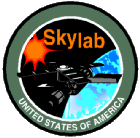 The Skylab
Program
The Skylab
Program The Skylab
Program
The Skylab
Program


NASA had studied various concepts for a space station, including inflatable donuts, Chesley Bonestell's magnificent "Wheel," and various other designs since the earliest beginnings of the space program. When the Saturn rocket was developed in the mid-'60s, enabling some heavy lifting into space, the Skylab Program began to take shape. Following cancellation of Apollo 18, 19 and 20, we had a lot of hardware lying around gathering dust, so we put it to some remarkably good use.
At first there were two competing concepts for a space station. The first, called the "Wet Concept," called for launching a Saturn 1B, venting the S IV-B upper stage and refurbishing it, converting it to the space station, while in orbit. The second, or "Dry Concept," called for outfitting the S IV-B while still on the ground and launching it atop a Saturn V. While the Apollo 11 astronauts were actually on the moon in July, 1969, the decision was made to go with the Dry Concept.
Skylab weighed about 100 tons, and its launch marked the last launch of the wonderful Saturn V, the rocket that never failed. It had a volume of 283.17 cubic meters and was separated into two "floors;" the "upper" floor contained storage lockers and a large empty space for conducting experiments, and two airlocks, one pointed "down" toward the earth and the other "up" toward the sun; the "lower" floor was divided into rooms including a dining room with a table, three bedrooms, a work area, a bathroom and a shower. The floors consisted of an open gridwork that fit cleats on the bottom of the astronauts' shoes.
The station was also equipped with an airlock module for the many spacewalks that were required to change film in the external cameras and make repairs to the station. The Apollo Command and Service Modules remained attached to the station's docking mechanism for the duration of the astronauts' stays aboard the station.
The largest piece of scientific equipment was the "Apollo Telescope Mount" or ATM, which had its own solar panels for electricity generation and was used to make apectrographic analyses of the Sun without interference from Earth's atmosphere.
Launch of the unoccupied Skylab, designated Skylab 1 (the occupied missions were officially designated Skylabs 2, 3 and 4, but are generally referred to as Skylabs I, II and III, and are referred to in that manner here) took place on May 14, 1973, and problems set in early on. One minute and three seconds into launch, the meteorite shield/sunshade was torn loose by the aerodynamic forces, destroying one of the solar arrays and damaging the other. The first crew, Skylab I, which was supposed to launch the next day, was delayed for ten days while mission personnel devised a method to repair the crippled station.
In all, three crews were launched, each in turn setting a record for longest human space flight; the all-time American record, which stood until Norm Thagard broke it aboard Mir in 1995, was set by Skylab III at over 2,017 hours (three months) and 1,214 orbits of the earth. The Skylab program totalled 513 man-days in orbit, conducted thousands of experiments in many different disciplines, and even viewed the rather disappointing comet Kohoutek from Skylab III.
Skylab's orbit slowly deteriorated and it finally burned up in the atmosphere
on July 11, 1979, more than five years after the last crew left for home.



